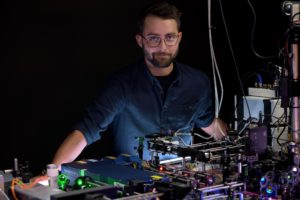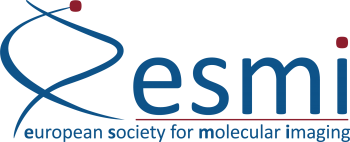Congratulations!
The PhD Award for excellent PhD thesis 2020 goes to Markus Seeger, Munich (now Boston) for his work on
Hybrid microscopy: A novel microscope integrating advanced optical and optoacoustic modalities for multi-modal examinations of biological specimens
Committee Statement
“In his PhD thesis, Markus presented the development and applications of its new microscope the hybrid multi-photon and spectral optical-resolution optoacoustic microscope (HyMPSOM), an optical system that merges seven modalities into a single device. The committee was impressed by the amount of creativity inside the PhD’s manuscript and the incredible number of applications covering many fields of our molecular imaging society. With HyMPSOM, Markus Seeger and his team obtained amazing images from the delicate subcellular level in living cells or organoids to in vivo brand new spatio-temporal dynamic imaging of the healing process. Besides, Markus managed to impulse innovation in another significant field: thanks to the unique capabilities of his imaging system, he proposed novel contrast agents enabling exciting new biomedical applications. We are looking forward to follow his scientific achievements in the future and to welcome him at our next EMIM.
Congratulations, Markus!“
Abstract
The first part introduces the hybrid multi-photon and spectral optical-resolution optoacoustic microscope (HyMPSOM), an optical system that merges seven modalities into a single device and facilitates simultaneous multi-modal investigations with subcellular resolution, deep imaging, fast acquisition, and high sensitivity.
The second part concerns the utilization of the multi-contrast imaging capability of HyMPSOM to investigate biological and biomedical specimen as well as to explore novel designed multi-modal contrast agents.
The final part presents technical extensions of HyMPSOM for performing microscopic optoacoustic sensing and imaging beyond the standard mode of operation.
Conclusively, the (herein) devised and further developed hybrid microscope evolved to a versatile platform evincing the operational capability of advanced multimodal microscopy for biological and biomedical research. By fusing several powerful microscopy modalities into a single device, HyMPSOM is characterized by a multifaceted and unique potential to comprehensively study specimens from single-cells to small animals, to exploit multi-modal contrast to gain new insights into the microscopic properties of living species, to assist the development of novel contrast agents, and to advance the field of optoacoustic technologies on the microscale.
Impact of work (by Markus)
My general research interest as a biophysicist is dedicated to pushing the boundaries of biomicroscopy at the junction between developing hard- and software, conceptualizing novel approaches for accessing microscopic contrast, and conducting translational multimodal biomicroscopy. I am aspired to develop novel technology of next-generation transformative biomicroscopy for biomedical research enabling so far un-achieved insights into an organism’s condition, with an emphasis on label-free and dynamic interrogating of the elementary building blocks of living organisms, the cells.
Cells contain the so-called ‘molecules of life’ subdivided into proteins, nucleic acids, carbohydrates, and lipids that are continually exposed to dynamic changes in their (micro)environment, where small alterations in their structural, functional, and metabolic composition regulate the fragile balance between health and disease. My approach seeks to
(1) combine and exploit specific types of light-matter-interactions as contrast mechanisms to enlarge the set of detectable biological moieties;
(2) avoid potentially toxic labeling strategies to allow for real-time, longitudinal, and harmless measurements of living specimens;
(3) augment the functional principle of microscopy modalities commonly used in the photonic community to enhance imaging depth, speed, and precision;
(4) refine imaging capabilities for specific research questions; and
(5) facilitate the drawing of conclusions on biological functionalities, pathological principles, and treatment options.
The accelerating interest of biomedical research renders the need for novel imaging technology to surpass the current limitations of biomicroscopy in the field of applied photonics.
Winner 2020

“Markus worked as a doctoral candidate and independent project leader at the IBMI from June 2015 until April 2020. Upon joining my group, Markus took over responsibility of a nascent project to improve a novel hybrid microscope. He instituted massive technological improvements to the device. The resulting imaging capabilities of “Markus’s microscope” were so impressive that the device became an integral part of numerous projects within the lab and with external collaborators.
In his doctoral thesis, Markus describes the development and optimization of an advanced optical and optoacoustic microscopy system for multimodal imaging of different biological tissue components, the HyMPSOM (‘hybrid multi-photon and spectral optical-resolution optoacoustic microscope’).”
Vasilis Ntziachristos – supervisor
Full-text Thesis
Thesis is still under a retention period and will be made available afterwards.
